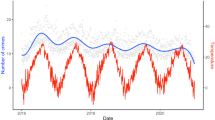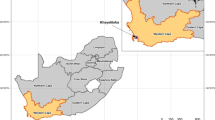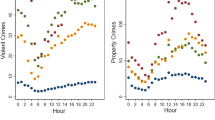Abstract
Urban crime may be an important but overlooked public health impact of rising ambient temperatures. We conducted a time series analysis of associations between temperature and crimes in Philadelphia, PA, for years 2006–2015. We obtained daily crime data from the Philadelphia Police Department, and hourly temperature and dew point data from the National Centers for Environmental Information. We calculated the mean daily heat index and daily deviations from each year’s seasonal mean heat index value. We used generalized additive models with a quasi-Poisson distribution, adjusted for day of the week, public holiday, and long-term trends and seasonality, to estimate relative rates (RR) and 95% confidence intervals. We found that the strongest associations were with violent crime and disorderly conduct. For example, relative to the median of the distribution of mean daily heat index values, the rate of violent crimes was 9% (95% CI 6–12%) higher when the mean daily heat index was at the 99th percentile of the distribution. There was a positive, linear relationship between deviations of the daily mean heat index from the seasonal mean and rates of violent crime and disorderly conduct, especially in cold months. Overall, these analyses suggest that disorderly conduct and violent crimes are highest when temperatures are comfortable, especially during cold months. This work provides important information regarding the temporal patterns of crime activity.





Similar content being viewed by others
References
Krug EG, Mercy JA, Dahlberg LL, Zwi AB. The world report on violence and health. Lancet. 2002;360(9339):1083–8.
Dustmann C, Fasani F. The effect of local area crime on mental health. Econ J. 2016;126(593):978–1017.
Evenson KR, Block R, Diez Roux AV, McGinn AP, Wen F, Rodriguez DA. Associations of adult physical activity with perceived safety and police-recorded crime: the multi-ethnic study of atherosclerosis. The International Journal of Behavioral Nutrition and Physical Activity. 2012;9:146.
Garvin EC, Cannuscio CC, Branas CC. Greening vacant lots to reduce violent crime: a randomised controlled trial. Inj Prev. 2013;19(3):198–203.
Wolfe MK, Mennis J. Does vegetation encourage or suppress urban crime? Evidence from Philadelphia, PA. Landsc Urban Plan. 2012;108(2–4):112–22.
Du Y, Law J. How do vegetation density and transportation network density affect crime across an urban central-peripheral gradient? A case study in Kitchener-Waterloo, Ontario. Isprs Int J Geo-Inf. 2016;5(7):118. doi:10.3390/ijgi5070118.
Linning SJ, Andresen MA, Brantingham PJ. Crime seasonality: examining the temporal fluctuations of property crime in cities with varying climates. Int J of offender therapy and comparative criminology. 2016. doi:10.1177/0306624X16632259.
Miro F. Routine activity theory. The encyclopedia of theoretical criminology. 2014:1–7. doi:10.1002/9781118517390.wbetc198.
Anderson CA, Anderson DC. Ambient temperature and violent crime: tests of the linear and curvilinear hypotheses. J Pers Soc Psychol. 1984;46(1):91–7.
Basu R. High ambient temperature and mortality: a review of epidemiologic studies from 2001 to 2008. Environ Health. 2009;8:40.
Basu R, Pearson D, Malig B, Broadwin R, Green R. The effect of high ambient temperature on emergency room visits. Epidemiology. 2012;23(6):813–20.
Green RS, Basu R, Malig B, Broadwin R, Kim JJ, Ostro B. The effect of temperature on hospital admissions in nine California counties. Int J Public Health. 2010;55(2):113–21.
Hsiang SM, Burke M, Miguel E. Quantifying the influence of climate on human conflict. Science. 2013;341(6151):1235367.
Hsiang SM, Burke M. Climate, conflict, and social stability: what does the evidence say? Clim Chang. 2014;123(1):39–55.
Hsiang SM, Meng KC, Cane MA. Civil conflicts are associated with the global climate. Nature. 2011;476(7361):438–41.
Anderson CA. Temperature and aggression: ubiquitous effects of heat on occurrence of human violence. Psychol Bull. 1989;106(1):74–96.
Anderson CA. Heat and violence. Curr Dir Psychol Sci. 2001;10(1):33–8.
Rotton J, Cohn EG. Global warming and U.S. crime rates: an application of routine activity theory. Environ Behav. 2003;35(6):802–25.
Philadelphia Co. OpenDataPhilly. https://www.opendataphilly.org Accessed 10 Jan 2017.
Information NNCfE: Datda access. https://www.ncdc.noaa.gov/data-access (2016). Accessed 12 Feb 2016.
Anderson BG, Bell ML. Methods to calculate the heat index as an exposure metric in environmental health research. Environ Health Perspect. 2013;121(10):1111–9.
Bhaskaran K, Gasparrini A, Hajat S, Smeeth L, Armstrong B. Time series regression studies in environmental epidemiology. Int J Epidemiol. 2013;42(4):1187–95.
RStudio: Integrated Development for R. Computer program. Boston, MA: RStudio, Inc; 2015.
Gasparrini A. Distributed lag linear and non-linear models in R: the package dlnm. J Stat Softw. 2011;43(8):1–20.
Gamble JL, Hess JJ. Temperature and violent crime in Dallas, Texas: relationships and implications of climate change. West J Emerg med. 2012;13(3):239–46.
Michel SJ, Wang H, Selvarajah S, et al. Investigating the relationship between weather and violence in Baltimore, Maryland, USA. Injury. 2016;47(1):272–6.
Butke P, Sheridan SC. An analysis of the relationship between weather and aggressive crime in Cleveland, Ohio. Weather Clim Soc. 2010;2(2):127–39.
Rotton J, Cohn EG. Violence is a curvilinear function of temperature in Dallas: a replication. J Pers Soc Psychol. 2000;78(6):1074–81.
Mares D. Climate change and levels of violence in socially disadvantaged neighborhood groups. J Urban Health. 2013;90(4):768–83.
Sorg ET, Taylor RB. Community-level impacts of temperature on urban street robbery. J Crim Just. 2011;39(6):463–70.
State of the climate: global analysis for February 2016. http://www.ncdc.noaa.gov/sotc/global/201602 (2016). Accessed 17 Jan 2017.
IPCC. Climate change 2014: synthesis report. Contribution of Working Groups I, II, and III to the Fifth Assessment Report of the Intergovernmental Panel on Climate Change. Geneva, Switzerland: IPCC;2014.
Acknowledgements
This work was funded, in part, by a pilot grant from the Drexel University Dornsife School of Public Health Urban Health Collaborative, internal funding number 282671.
Author information
Authors and Affiliations
Corresponding author
Electronic supplementary material
Below is the link to the electronic supplementary material.
ESM 1
(DOCX 196 kb)
Rights and permissions
About this article
Cite this article
Schinasi, L.H., Hamra, G.B. A Time Series Analysis of Associations between Daily Temperature and Crime Events in Philadelphia, Pennsylvania. J Urban Health 94, 892–900 (2017). https://doi.org/10.1007/s11524-017-0181-y
Published:
Issue Date:
DOI: https://doi.org/10.1007/s11524-017-0181-y




